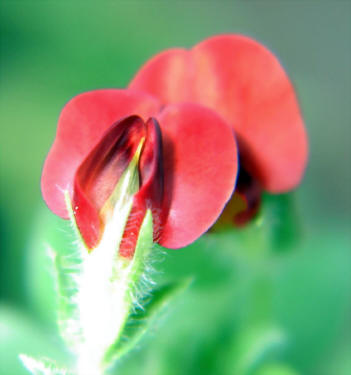Julie Falk
Adams County Master Gardener
 As the season for harvest draws to a close, the gardener's season for reflection begins. We evaluate which aspects of our gardens were successful, where we made our miscalculations, and what might be nice in our next garden. Next
year, I'd like my garden to be more related to my personal value of preserving biological diversity. I only grew one heirloom variety this year; my asparagus peas were widely planted in the 1700s, but are nowhere seen at the supermarket today. We can conserve some of the best flavors of the past by revisiting some of the
heirlooms. Saving seeds is a skill that will enable us to preserve heirlooms or simply carry our favorite features from this year's garden into the coming year.
As the season for harvest draws to a close, the gardener's season for reflection begins. We evaluate which aspects of our gardens were successful, where we made our miscalculations, and what might be nice in our next garden. Next
year, I'd like my garden to be more related to my personal value of preserving biological diversity. I only grew one heirloom variety this year; my asparagus peas were widely planted in the 1700s, but are nowhere seen at the supermarket today. We can conserve some of the best flavors of the past by revisiting some of the
heirlooms. Saving seeds is a skill that will enable us to preserve heirlooms or simply carry our favorite features from this year's garden into the coming year.
It wasn't until the early 1800s that seeds were packaged for sale. Prior to that time, it was essential to save seeds if one planned to continue eating. The advent of the seed catalog brought ease and a certain pleasure into garden planning, but there are still some good reasons to learn to save
seeds. You might like the flavor, texture, fruiting time, color or other characteristic of a particular crop. For many varieties of plants, the seeds of the parent plant will reproduce your favorite feature next season. Here are the easiest plants for your first attempt at seed-saving, and a few technical pointers.
First, a bit of biology. You need not save seeds from plants that are marketed as "hybrids". Hybrids are the offspring of two parent plants that have different characteristics. The seed of a hybrid plant can therefore revert to the characteristics of either parent, and will not reproduce the
vegetable or fruit you fell in love with. The most reliable plants for seed-saving are those that pollinate themselves. They are fertilized by their own pollen without action from wind or insects. These include tomatoes, lettuce, peas, snap beans, soybeans, and lima beans. There are many hybrid varieties of these
vegetables, so be sure to save seeds only from non-hybrids.
|

Asp Pea
|
When saving seed, choose seeds from healthy plants that have the features you most desire. The fruit and seed must be fully mature, so this is done at the end of the season after you have harvested crops for eating. Seeds are generally mature when they have darkened, or when pods have turned brown
and dry on the plant. Dry seeds like beans, peas, carrot seeds, and most flowers and herbs are spread on a screen in a dry, ventilated area. Seedheads with small, light seeds can be placed into paper bags that will catch tiny seeds as they fall. Seeds that grow in a fleshy fruit (melons, tomatoes, cucumbers, squashes,
roses) require a wet preparation. Scoop out the seed mass and place it in a small amount of warm water. Let this mixture ferment for 2-4 days, stirring daily. Good, viable seeds will sink to the bottom of the container, while pulp and bad seeds float on the surface. Drain off the bad stuff, and spread the good seeds on a
screen or paper towel to dry. Put your dry seeds in a jar or envelope that is labeled with the date and seed type. Place the seeds in the freezer for two days to kill pests, and then store in a cool, dry place like the refrigerator. Some seeds are only good for a year, but most are viable if used within three years.
Saving seeds can make a plant your personal treasure, but the concept of heirloom varieties touches on a larger concern. In America, the foods we eat are often the result of careful breeding to develop products that ship and package well. This process has sometimes sacrificed flavor and nutrition in
our foods. You may have a preference for eggs from free-range chickens for just this reason. Or how about those pale winter tomatoes that are shipped green? In addition to aesthetic points, our mass production of food also lessens genetic diversity. When the only corn sold in stores is a particular white sweet corn, all
the other varieties of corn tend not to be grown. And the genetic characteristics of all those varieties drift out of the gene pool. Why is that a problem? Well, if a disease arises that attacks white sweet corn, we can have staggering losses, and no other varieties to fall back on. The famous Irish Potato Famine in 1848
was such an event.
There are several organizations that specialize in saving the seeds of historical plant varieties. If you conduct an internet search on "heirloom seeds" a number of catalogs will be indicated, enabling you to obtain heirloom seeds that have been saved by others. "Seedsavers.org" is a particularly
fruitful website if you'd like to explore growing a little piece of history in your garden. You can find Cherokee Trail beans, carried by the Cherokee in 1835 on their forced march from the Smoky Mountains to Oklahoma. Or Arikara Bride corn, which might have been seen by Lewis and Clark on their famous journey of 1803.
There are many heirloom varieties grown and conserved by the Amish for generations, which are likely to do well in our area. Growing an heirloom and saving its seeds is a worthy mission for one little corner of your garden next year.
Read other articles on gardening techniques
Read other articles by Julie Falk